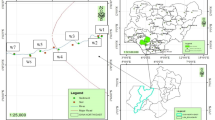Abstract
Suspended and bed sediments collected from the entire region of the Krishna River and its major tributaries were analyzed for heavy metals (V, Cr, Mn, Fe, Co, Ni, Cu, Zn, and Pb) by the thin-film energy dispersive x-ray fluorescence technique. There is considerable variation in the concentration of elements towards downstream, which may be due to the variation in the subbasin geology and various degrees of human impact. Suspended particles are enriched in heavy metals throughout the basin relative to bed sediments. The heavy metals are enriched in coarse size fractions (10–90 µm) throughout the Krishna River except its tributary Bhima, where finer fractions (2 µm) dominate. Transition elements correlate very well with each other. There is a striking similarity between the bed sediments of Krishna River and the Indian average. When the annual heavy metal flux carried by the Krishna River was estimated, and viewed in relation to the other major riverine transport, the Krishna is seen to be a minor contributor of heavy metals to the Bay of Bengal.
Similar content being viewed by others
References Cited
Abbas, N., and V. Subramanian, 1984, Erosion and sediment transport in the Ganges River basin (India): Journal of Hydrology, v. 69, p. 173–182.
Berner, E. K., and R. A. Berner, 1987, The global water cycle, geochemistry and environment. Englewood Cliffs, NJ, Prentice-Hall, Inc., 397 p.
Biksham, G., and V. Subramanian, 1988, Sediment transport of Godavari River basin and its controlling factors: Journal of Hydrology, v. 101, p. 275–290.
Bowen, H. J. M., 1979, Environmental chemistry of the elements. New York, Academic Press, 320 p.
Bradley, S. B., 1982, Sediment quality related to discharge: International Association of Hydrological Sciences v. 137, p. 341–347.
Chaturvedi, M. C., 1973, Indian national water plan and grid, First world congress on water resources: Internation Water Resources Association, Chicago, 122 p.
Forstner, U., 1977, Metal concentrations in fresh water sediments-natural background and cultural effect;in H. L. Golterman, ed., Interactions between sediments and fresh water, The Hague, Junk, p. 94–100.
Forstner, U., and G. T. W. Wittmann, 1981, Metal pollution in the aquatic environment: Berlin, Springer-Verlag, 486 p.
Gibbs, R. J., 1973, Mechanisms of trace metal transport in rivers: Science, v. 180, p. 71–72.
Gibbs, R. J., 1977, Transport phases of transition metals in the Amazon and Yukon rivers: Geological Society of America Bulletin, v. 88, p. 829–843.
Guy, H. P., 1977, Laboratory theory and methods for sediment analysis: Technical water-resources inventory. Book 5, Chap. Cl, p. 23–28.
Helmke, P. A., R. D. Koons, P. J. Schomberg, and I. K. Iskander, 1977, Determination of trace element contamination of sediments by multi element analysis of clay size fraction: Environmental Science and Technology, v. 11, p. 984–991.
Li, Y. H., H. Teraoka, T. S. Yang, and J. S. Chen, 1984, The elemental composition of suspended particles from the Yellow and Yangtze rivers: Geochimica Cosmochimica Acta, v. 48, p. 1561–1564.
Martin, J. M., and M. Meybeck, 1979, Elemental mass balance of material carried by major world rivers: Marine Chemistry, v. 7, p. 173–206.
Martin, J. M., and M. Whitfield, 1981, The significance of the river input of chemical elements to the ocean: C. S. Wong, E. Boyle, K. W. Bruland, J. D. Burton and E. D. Goldberg, eds.,in Trace metals in sea water, New York, Plenum Press, p. 265–296.
Milliman, J. D., and R. H. Meade, 1983, World-wide delivery of river sediment to the oceans: Journal of Geology, v. 91, p. 1–21.
Milliman, J. D., Q. Y. Shan, R. Mei, and Y. Saito, 1987, Man's influence on the erosion and transport of sediment by Asian rivers: the Yellow river (Huanghe) example: Journal of Geology, v. 95, p. 751–762.
Muller, G., and U. Forstner, 1975, Heavy metals in the Rhine and Elbe estuaries: mobilization or mixing effect: Environmental Geology, v. 1, p. 33–39.
Ramesh, R., 1985, Geochemistry of Krishna River basin: PhD thesis, Jawaharlal Nehru University, New Delhi, 228 p.
Ramesh, R., and V. Subramanian, 1986, Mass transport in Krishna River basin, India: IAHS v. 159, p. 185–197.
Ramesh, R., and V. Subramanian, 1988, Temporal, spatial and size variation in the sediment transport in Krishna River basin, India: Journal of Hydrology, v. 98, p. 53–65.
Sarin, M. M., D. V. Borole, and S. Krishnaswami, 1979, Geochemistry and geochronology of sediments from Bay of Bengal and equatorial Indian ocean: Proceedings of the Indian Academy of Science, v. 88A, p. 131–154.
Subramanian, V., 1978, Input by Indian rivers into the world oceans: Proceedings of the Indian Academy of Science, v. 87A, p. 77–88.
Subramanian, V., 1987, Environmental geochemistry of Indian river basins—a review: Geological Society of India, v. 29, p. 205–220.
Subramanian, V., 1979, Chemical and suspended sediment characteristics of rivers of India: Journal of Hydrology, v. 44, p. 37–55.
Subramanian, V., L. Van't dack and R. Van Grieken, 1985a, Preliminary studies on the geochemistry of the Cauvery River basin: Proceedings of the Indian Academy of Science, v. 94, p. 99–110.
Subramanian, V., R. Van Grieken, and L. Van't dack, 1985b, Chemical composition of river sediments from the Indian subcontinent. Chemical Geology, v. 48, p. 271–279.
Subramanian, V., R. Van Grieken, and L. Van't dack, 1987, Heavy metals distribution in the sediments of Ganges and Brahmaputra rivers: Environmental Geology and Water Science, v. 9, p. 93–103.
Van Dyck, P. M., and R. Van Grieken, 1980, Absorption correction via scattered radiation in energy-dispersive x-ray fluorescence analysis for samples of variable composition and thickness: Analytical Chemistry, v. 52, p. 1859–1864.
Van Grieken, R. E., L. Van't dack, C. Costa Dantas, and H. De Silveira Dantas, 1979, Soil analysis by thin-film energy-dispersive x-ray fluorescence: Analytica Chimica Acta, v. 108, p. 93–101.
Author information
Authors and Affiliations
Rights and permissions
About this article
Cite this article
Ramesh, R., Subramanian, V. & van Grieken, R. Heavy metal distribution in sediments of Krishna River basin, India. Environ. Geol. Water Sci 15, 207–216 (1990). https://doi.org/10.1007/BF01706412
Issue Date:
DOI: https://doi.org/10.1007/BF01706412




